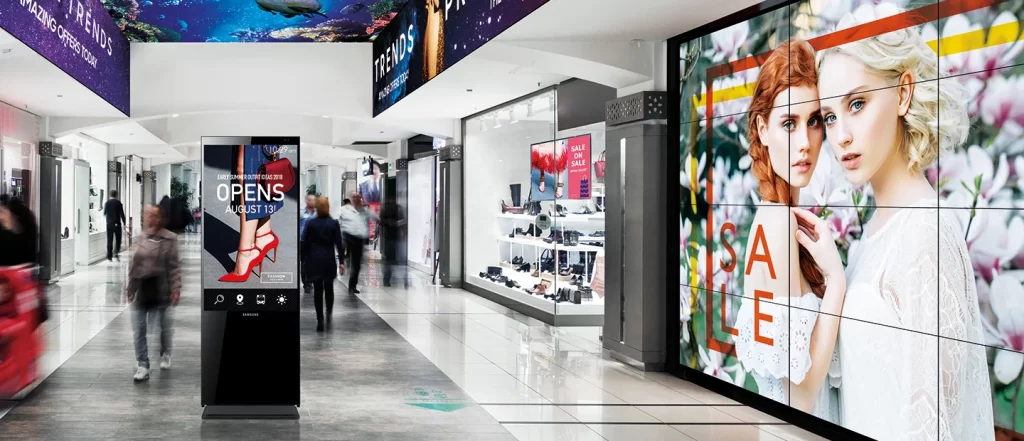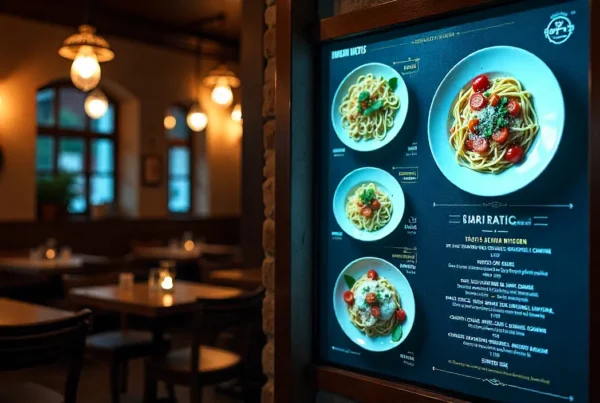Retail in the current world is all about memorable immersive experiences. Shopping malls digital signage is an intersection of technology and customer experience, turning the corridors into content-rich walkways that inform, inspire, and convert. We break it down below: how digital signage for shopping mall has developed, why it is better than a static display, and the best practices to achieve real outcomes, down to the wholesale hanging digital signage for shopping mall installations.
From Print to Pixels: The Evolution of Retail Media
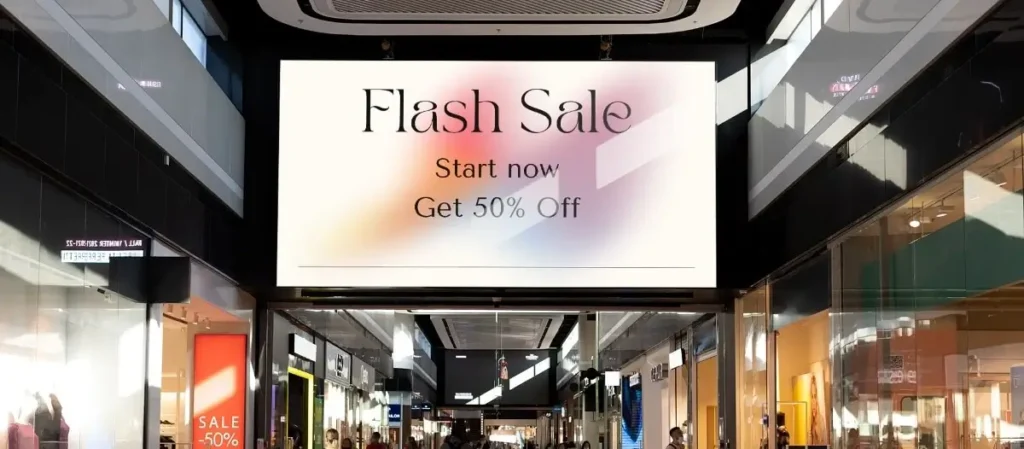
A mere ten years back, lightboxes and poster boards were the visual diet of retail. Now these have been substituted by digital signage in malls that consists of high-resolution LED and LCD screens, which can provide video loops, live feeds, and interactive content. Current systems combine digital signage software systems with real-time analytics and IoT connectivity to create a dynamic retail media space that can be updated in real time across dozens or hundreds of locations.
What Makes Shopping Mall Digital Signage Screens So Effective?
Essentially, a shopping mall digital signage screen is not just a screen, but a storytelling canvas. Through the combination of motion graphics, vivid imagery, and positioning, malls can:
• Grab Instant Attention: Movement and sound cut through the visual clutter of a busy concourse.
• Influence Purchases: Mid-Journey: Screens at decision points-near escalators or food courts-encourage customers toward promotions and upsells.
• Differentiate Brand Experiences: Build brand continuity across all screens that strengthens the mall brand identity and the brand of tenants.
The Psychology Behind Visual Storytelling
The processing of visual information is 60,000 times faster than text in humans. This implies that a thoughtfully designed video loop or motion graphic on a digital signage in malls solution can build an emotional bond within a few seconds- before shoppers read one word. Color psychology, narrative structures, and social proof (rotating customer testimonials, etc.) can help malls turn the passive display into persuasive, silent salespeople.
Defining Clear Objectives for Mall Signage
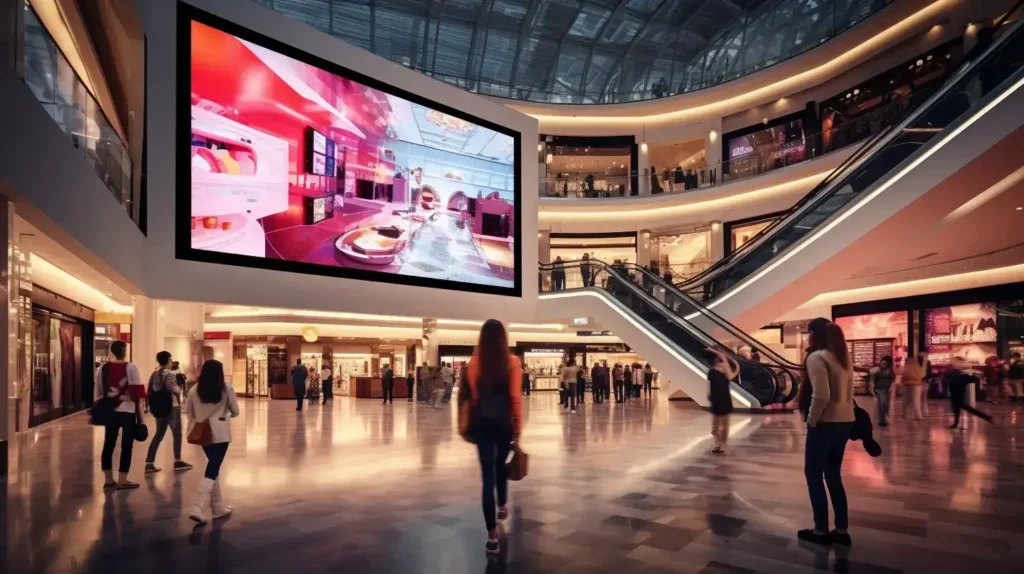
Effective implementations begin with specific goals:
Promotions and Sales by Car
Impulse purchases are triggered by a revolving carousel of limited-time deals or flash sales. As an example, a video loop that shows a 20 percent off shoe sale in the area of the footwear wing translates foot traffic into instant sales.
Wayfinding to Enhance Navigation
Mall layouts that are complex tend to frustrate visitors. Touchscreen mapping interactive wayfinding screens are used to guide the shoppers with recommended routes and live updates of the location of elevators and lavatories.
Lifting Events and Experiences
Whether it is a fashion show or holiday markets, malls can use digital screens to announce event schedules, highlight pop-up shops, and even stream live shows- making the mall a 24-hour hot spot.
Strategic Placement: Maximizing Exposure
Screens are not equal. The best digital signage shopping mall strategies include locating areas with high dwell-time, such as food courts, sitting areas, and rest areas, where shoppers spend their time. Suspended units, referred to as wholesale hanging digital signage for shopping mall, are placed in atriums and enjoy 360-degree visibility, whereas thin pillars and screens mounted in corridors support repetitive messaging.
Data-Driven Displays: Smarter, Not Harder
Using footfall sensors, heatmapping, and WiFi analytics, malls will be able to quantify screen engagement in real time. A display that is not performing can be refitted with new material or relocated to a busier location. This feedback loop allows digital signage in malls to be optimized for ROI, minimizing wasted impressions and maximizing investment in those screens that proved to be high impact.
Interactivity: Turning Viewers into Buyers
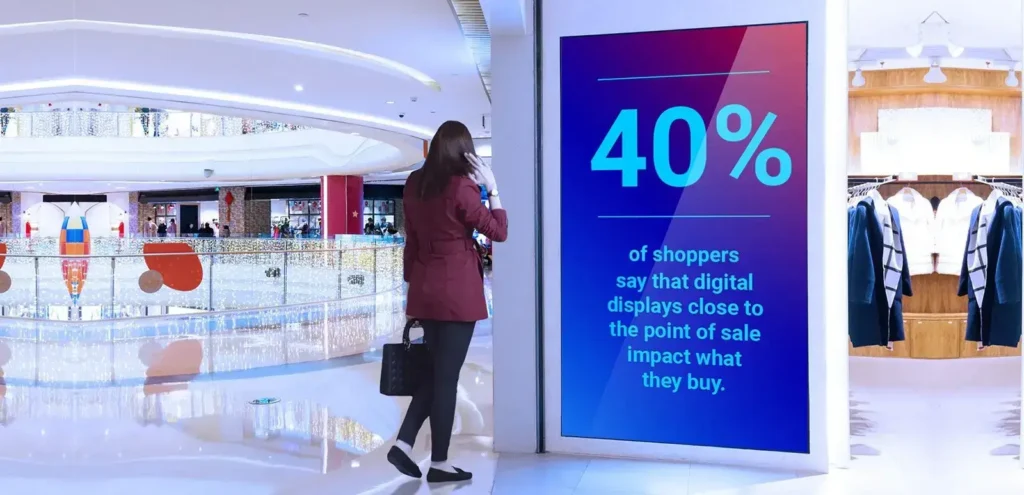
Interactive digital signage, touch screens, and voice-activated displays in particular stimulate clients to browse product catalogs, customize orders, or engage in competitions. When audiences are directly involved, the dwell time is also increased, and the path to purchase is shorter.
Seamless Mobile Integration with QR Codes
The integration of the QR code on the digital screen of the shopping malls combines the physical and digital mediums. A rapid scan may open up special offers, access a mall directory app, or direct shoppers to an online marketplace to make click-and-collect purchases. This convergence of screens and smartphones locks in an omnichannel shopping experience.
Seasonal & Event-Based Campaigns with Dynamic Content
Holiday Pop-Up Promotions
Apply themed templates, such as snowflakes in winter, florals in spring, so that screens would tell the season right away. Advertise time-sensitive pop-up shops and holiday offers.
Sales and Back-to-School Events
Countdown clocks and scrolling banners create anticipation over clearance sales or the back-to-school rush. The content can be switched between the most popular electronic products and fashion items according to the needs of the calendar.
In-Mall Experiences
Advertise live shows, workshops, or charity events through the display of schedules, performer biographies, and live ticket inventory on atrium video walls.
Branding Consistency Across Screens
Each digital screen supports the identity of the mall. Logos, color palettes, and typography are used consistently, and with the help of a digital signage style guide, they are used in such a way that the customers recognize the mall as a single brand, not a collection of tenant messages. The visual signature of the mall is enhanced by branded bumper loops and ambient background content within corridors, which have a subtle influence.
Wholesale Hanging Digital Signage: The Ultimate Impact
Video walls and suspended LED ribbons in large format are usually implemented by wholesale digital signage suppliers to provide immersive brand experiences. Whether it is panoramic welcome messages at the mall entrances or cascading promotional banners over central atriums, this hanging digital signage for shopping mall monopolizes the line of sight and create wow moments that even the static advertisements cannot.
Case Studies: Real-World Success
• Dubai Mall recorded a 30% increase in tenant revenues after implementing AI-powered digital screens that would customize offers to the target demographics of the shoppers.
• Westfield London was able to lower the number of wayfinding requests by 40% through interactive kiosks in its 200 retail stores.
• SM Megamall in Manila increased the attendance of seasonal events by 25% through dynamic holiday campaigns on digital signage screens in the shopping mall.
Future Trends in Retail Signage
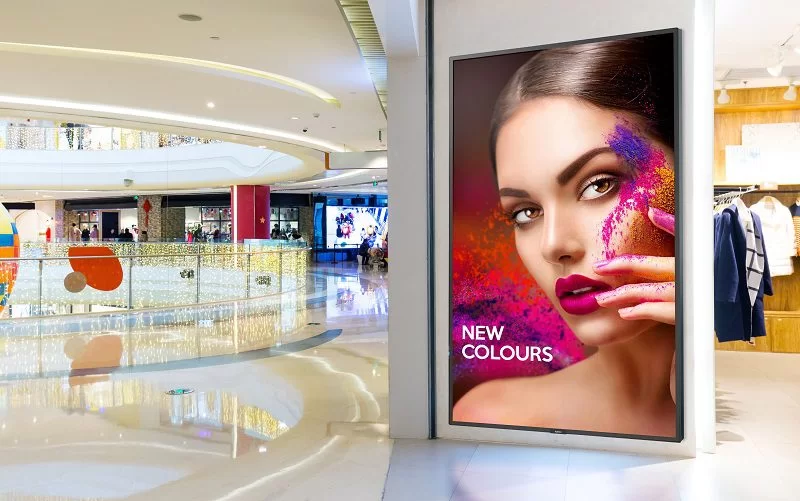
• AI-Generated Creative adjusts creative in real time using shopper data.
• Holographic & AR Overlays add three-dimensional previews of the products.
• Voice Commerce through screen-activated assistants speeds up the process of point-of-sale.
• Outdoor Displays are solar-powered and provide environmentally friendly messages in open-air promenades.
Elevate Your Mall’s Visual Impact Today
Do not allow your mall to be stuck with the use of static signs. Welcome shopping malls digital signage and develop a data-driven, interactive environment in which each screen is a chance to inform, engage, and sell. Collaborate with one of the most successful digital signage providers to create, implement, and optimize your network–and see your foot traffic and revenues increase.
FAQs: Everything You Need to Know
Q1. What ROI can malls expect from digital signage?
Promotion-driven sales at malls typically increase 20-30 percent and print costs are greatly reduced.
Q2. How long do commercial signage screens last?
Average of 5-7 years with modular parts to allow easy maintenance.
Q3. Is remote management essential?
Definitely, shopping mall networks using cloud-based digital signage software are real-time and highly scalable.
Q4. Can hanging installs be cost-effective?
Yes–wholesale hanging digital signage to shopping mall buying programs and modular LED panels reduce per-unit costs of large-scale deployments.
Q5. Do I need an in-house team to run it?
The user interfaces of most digital signage CMS are intuitive; day-to-day content management and scheduling can be done by a small communications team.

